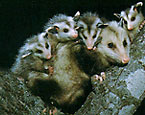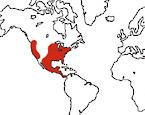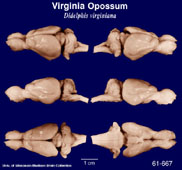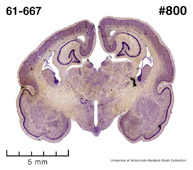|
Virginia
Opossum
(Didelphis virginiana) #61-667 |
||||
|
|
Physical
characteristics and distribution
|
|
Virginia Opossum have short legs with the hind limbs being slightly longer. Each foot has five separate digits with opposable, clawless hallux. This gray to brown marsupial has a long pointed, flattened muzzle, small, thin hairless ears, and a nearly naked scaly prehensile tail. Total length varies between 350 and 940 mm, tail length varies between 216 and 470mm. Males are larger than females with male weight ranging from 0.8 to 6.4 kg and female weight ranging from 0.3 to 3.7 kg This marsupial is primarily solitary and nocturnal. Opossums nest in tree hollows lined with leaves and is both arboreal and terrestrial. Females have a well-developed pouch and produce an average of 7 young per litter. Gestation is 12-13 day, with the young weaned at 100-101 days of age. After leaving the pouch, the young ride on the mother's back by clinging to her fur. The teeth are rooted and sharp with large canines. Virginia Opossum are omnivorous, with a diet including plants, fruit, insects, eggs, grains, carrion, and small vertebrates. The Virginia Opossum is the only marsupial found in the United States. Virginia Opossums are found in S Canada; E and C United States (introduced populations in Pacific states); Mexico and in Central America south into N Costa Rica. |
|
Description
of the brain
|
|
Animal
source and preparation
|
|
All
specimens collected followed the same preparation
and histological procedure.
|
Other Related Resources (websites and publications)
List of Specimens | Explore Collections | Brain Sections | Brain Evolution | Brain Development | Brain Circuitry | Brain Functions | Location and Use | Related Web Sites | Contact Us | Search MSU Database | Personnel | Home



